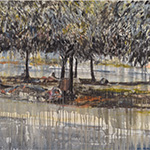Gallery Isabelle is pleased to announce the upcoming duo exhibition, Rest, featuring the distinctive works of Dubai-based artists Mohammed Kazem and Vikram Divecha. The exhibition will run from February 27 to April 15, 2024.
Rest delves into the intricate relationship between labour, rest, and the ever-evolving urban landscape of the UAE. Echoing T.J. Clark’s 20th century exploration of art in The Painting of Modern Life: Paris in the Art of Manet and His Followers (1984), the exhibition navigates the historical debate surrounding art’s reflection of social and economic life and the ‘struggle of representation.’
Considering the dynamics of human existence, alternating between cycles of depletion and restoration, the exhibition highlights the vital role of rest in the perpetual movement of cities. Driven by the forces of capitalism, desire, and aspiration, cities rely on the labour that fuels them. Rest challenges societal norms that discourage rest, aiming to disrupt the prevailing narrative and explore possibilities on the other side of exhaustion.
Through their distinct perspectives, Mohammed Kazem and Vikram Divecha challenge conventional narratives surrounding the representation of labour in the UAE. Both artists examine how workers, in direct opposition to the dominant culture’s desires and plans, reclaim their bodies and time. The systems in place often overburden labourers to increase profit: Rest serves as an outlier investigation and counternarrative.
“The ‘Dream’ aspect of rest work is deeply tied to the metaphysical and spiritual. It is a time to be free from the confines of linear and grounded reality,” says Tricia Hersey in Rest Is Resistance: A Manifesto.
This exhibition manifests a subculture that holds space for the blossoming of resistance, healing work, and the urge to deprogram.
Mohammed Kazem’s Urban Narratives
Kazem’s artistic journey unfolds through a series of paintings that capture the transient moments of labourers at rest. Skilfully using different lenses, he blurs the boundaries between focus and ambiguity, prompting viewers to question their perception of these non-productive yet profoundly significant periods. Kazem’s commitment to revisiting urban transformation breathes life into scenes where labourers contemplate life during bus rides, napping under trees, or day-dreaming.
Kazem’s recent works unmistakably resonate with his collection of 108 drawings on paper, Window 2011-2012, which traced scenes from photographs he has been taking around the UAE since 2003. These original photographs were accumulated by Kazem from trips around the seven Emirates, showing construction sites, busy highways, tired workers seated at the roadside, as well as the private and public social life of the country’s globalised population. But Kazem’s traced drawings lack colour, conveying a sense of anonymity and unnatural precision of line.
Similarly, in alignment with Even the Shade Does not Belong to Them (2018), in which Kazem painted the images of men in acrylic and washed them over in dark ink, his current paintings and drawings intentionally transcend the mere depiction of scenes, focusing on seizing instants. Kazem’s new works purposefully straddle the line between abstraction and figuration. Figures are glimpsed, as if seen through a moving window or fading into the landscape, recreating the labourers’ ever-present yet often unnoticed existence.
Vikram Divecha’s Collaborative Explorations
Divecha’s engagement with Sharjah’s Municipal gardeners in projects like Shaping Resistance (2015), Beej (2017) and Dohrana (2021) marks a shift in agency, allowing these workers a moment of self-expression and visibility. For Dohrana, Divecha prolonged his collaboration by working on crafting Urdu poems, which led to the making of a short film.
The film scenes take place in the green landscaping sites interspersed in the UAE’s highways and intersections. During weekends and break hours the migrant workforce flocks there to take a pause and unwind. Although not meant for public access, these ‘sites’ are claimed by the people of this city – giving them a new meaning beyond urban decoration ‘sights.’
Divecha’s Resting Bodies series, are studies based on sketches in those sites, observing how people rest, sleep, stretch their muscles, find comfort, and lounge. The resting silhouettes transform into ‘models,’ blurring the distinction between figures and a landscape of shapes. These shapes are sourced in Divecha’s memory of driving around the city, accumulating a topography of traffic islands and maps of green spaces at road turns, filter lanes, and interchange exits.
In another series of mixed-media, titled Resting Bodies (Pause), the resting body is presented within a commotion of lines signifying not just the movement of city, traffic, and roads but the movement of capital and its constant demand to fuel the system with labour and energy. Dignity cloaks the pauses that these drawings articulate through by contrasting the incessant urban flux and the stillness of resting bodies.
Both Divecha and Kazem’s final works transcend literal representation, morphing visible reality into non-figurative scenes or unfocused landscapes. They seek to visualise not just the visible world but the landscapes of the soul, merging what exists with the realms of the unexplored.
Press release from Gallery Isabelle
Image: Mohammed Kazem. Window. 2023. Acrylic, pastel, ink and marker on canvas. 100 x 150 cm. Image courtesy of the artist and Gallery Isabelle



